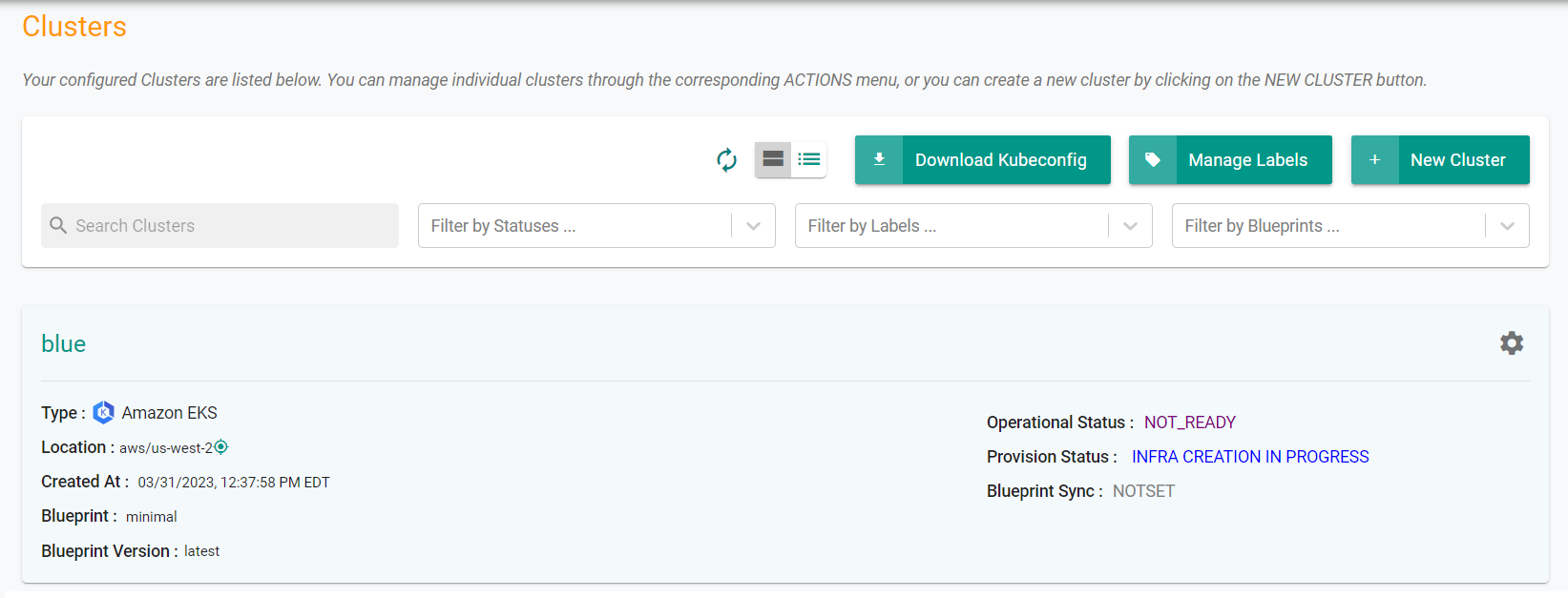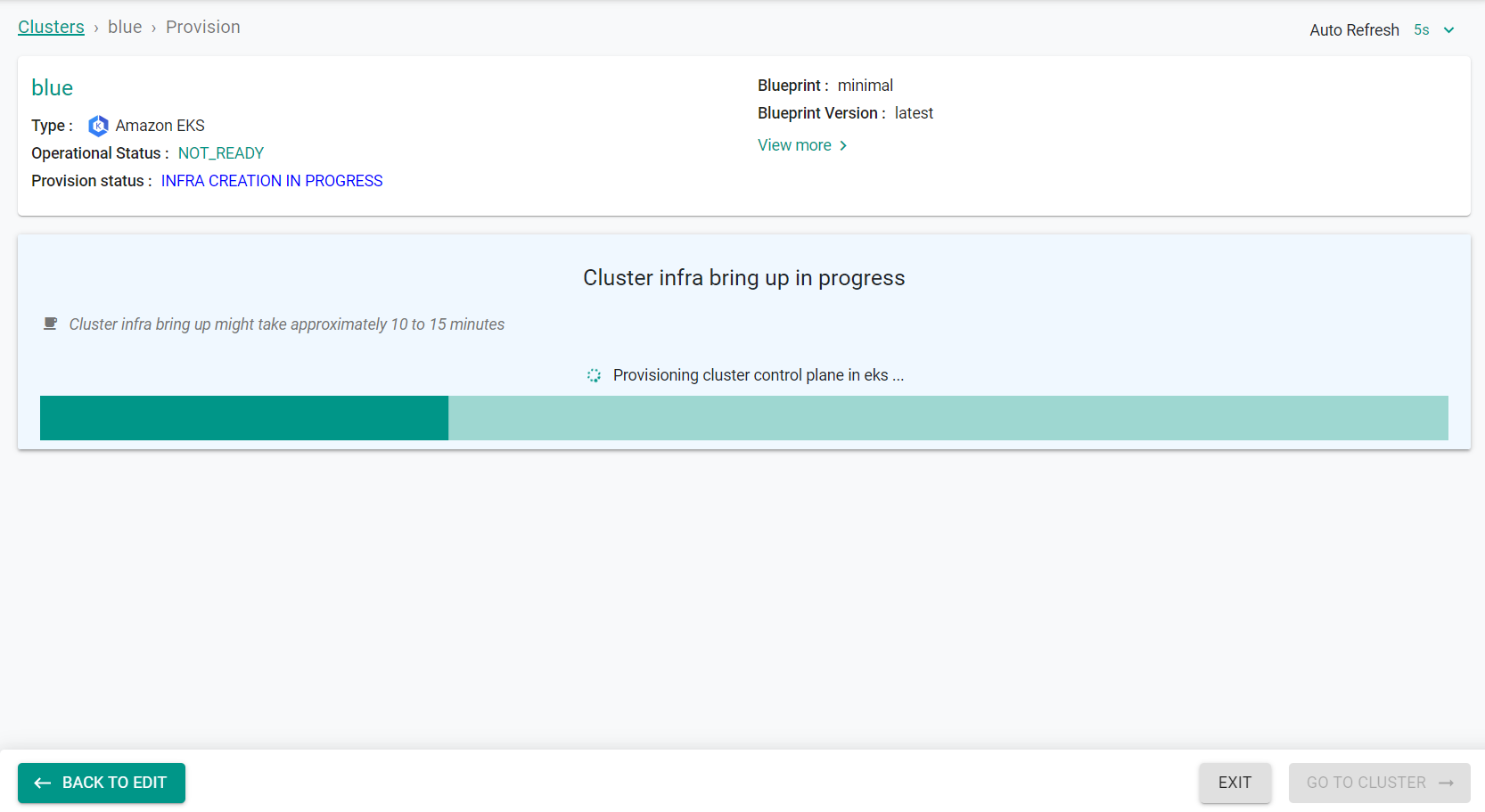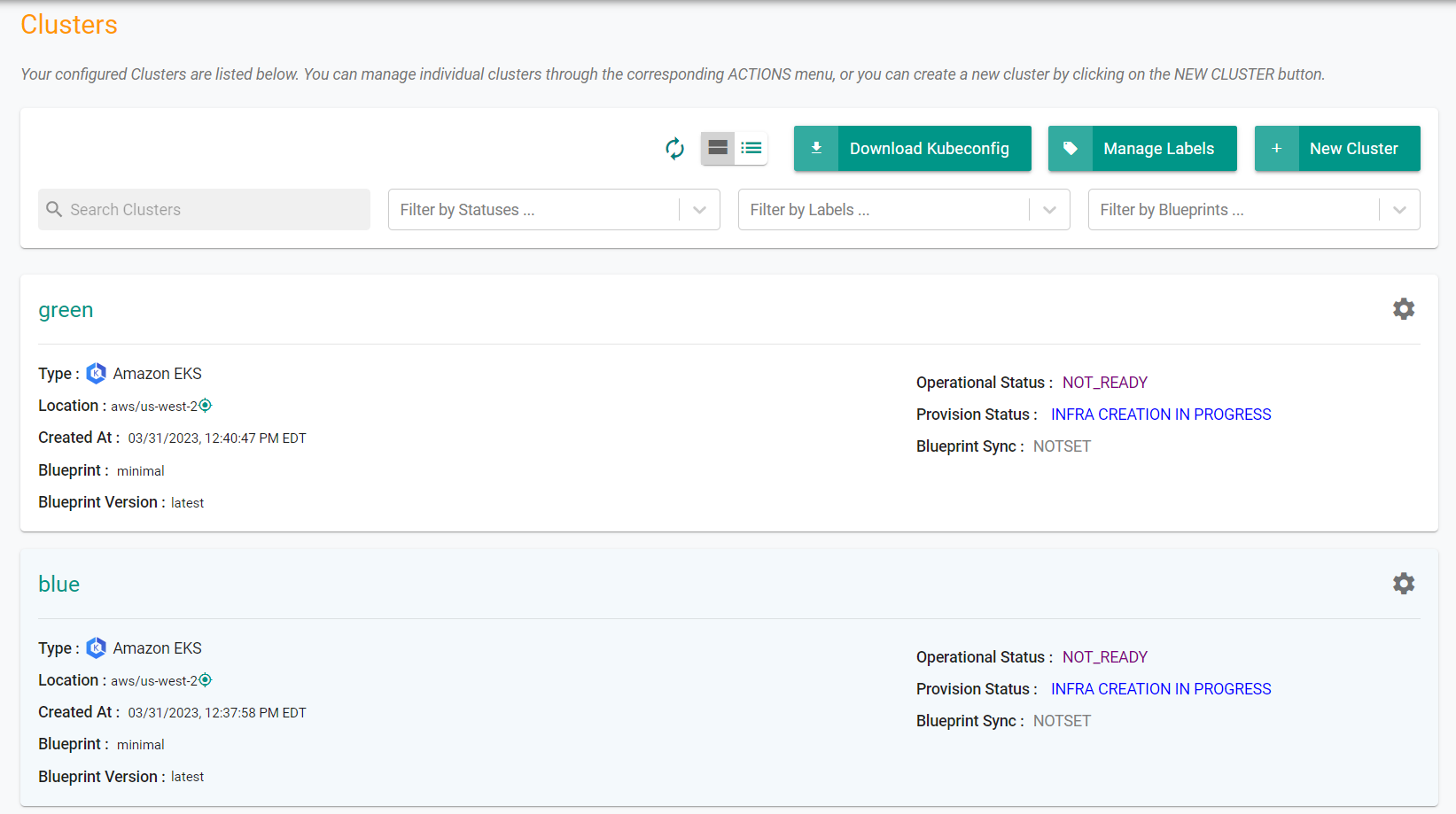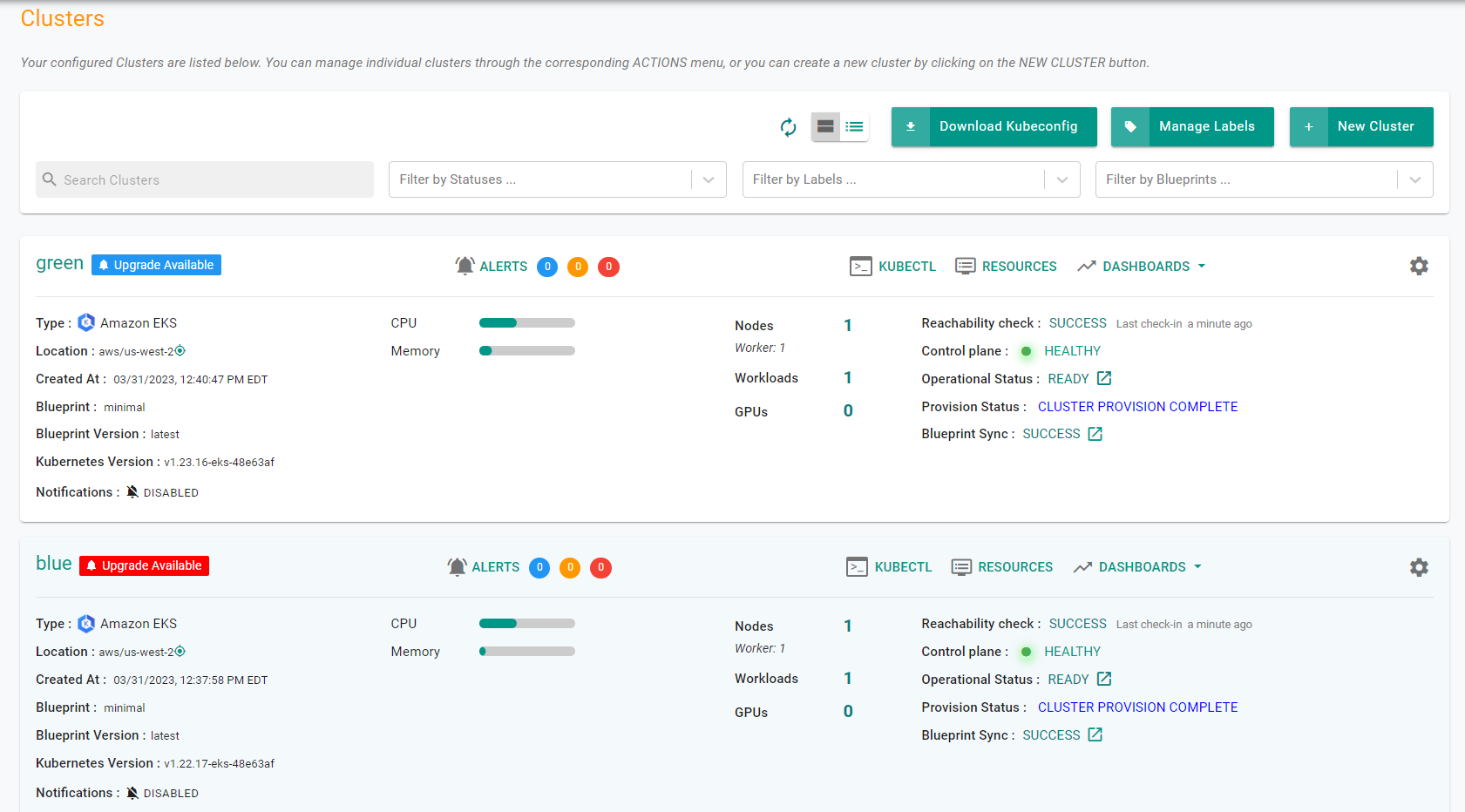Part 2: Provision
What Will You Do¶
In this part of the self-paced exercise, you will provision two Amazon EKS clusters based on declarative cluster specifications using the minimal blueprint. One of the clusters named blue will simulate an existing cluster running a stateless application on an older version of kubernetes. The other cluster named green will be running a newer version of kubernetes and will and simulate as the upgraded cluster we want to move our application to.
Step 1: Provision Blue Cluster¶
In this step, we will create the declarative cluster specification file for the blue cluster and use the RCTL CLI to provision the cluster from the specification file.
- Save the below specification file to your computer as "blue.yaml". Note, the highlighted sections in the spec will need to be updated to match your environment.
apiVersion: infra.k8smgmt.io/v3
kind: Cluster
metadata:
# The name of the cluster
name: blue
# The name of the project the cluster will be created in
project: defaultproject
spec:
blueprintConfig:
# The name of the blueprint the cluster will use
name: minimal
# The version of the blueprint the cluster will use
version: latest
# The name of the cloud credential that will be used to create the cluster
cloudCredentials: aws-cloud-credential
config:
# The EKS addons that will be applied to the cluster
addons:
- name: kube-proxy
version: latest
- name: vpc-cni
version: latest
- name: coredns
version: latest
iam:
# Enables the IAM OIDC provider as well as IRSA for the Amazon CNI plugin
withOIDC: true
managedNodeGroups:
# The AWS AMI family type the nodes will use
- amiFamily:
# The desired number of nodes that can run in the node group
desiredCapacity: 1
# The AWS EC2 instance type that will be used for the nodes
instanceType: t3.large
# The labels applied to the nodes in the node group
labels:
nodes:
# The maximum number of nodes that can run in the node group
maxSize:
# The minimum number of nodes that can run in the node group
minSize:
# The name of the node group that will be created in AWS
name: managed-system
metadata:
# The name of the cluster
name:
# The AWS region the cluster will be created in
region: us-west-2
# The Kubernetes version that will be installed on the cluster
version: latest
vpc:
# AutoAllocateIPV6 requests an IPv6 CIDR block with /56 prefix for the VPC
autoAllocateIPv6: false
clusterEndpoints:
# Enables private access to the Kubernetes API server endpoints
privateAccess: true
# Enables public access to the Kubernetes API server endpoints
publicAccess: true
# The CIDR that will be used by the cluster VPC
cidr: 192.168.0.0/16
type: aws-eks
Update the following sections of the specification file with details to match your environment
-
Update the project section with the name of the Rafay project to be used
project: defaultproject -
Update the cloudCredentials section with the name of the AWS cloud credential that was previously created
cloudCredentials: aws-cloud-credential -
Update the name and region sections with the cluster name and the AWS region where the cluster will be located
metadata: region: us-west-2 -
Save the updates that were made to the file
- Open Terminal (on macOS/Linux) or Command Prompt (Windows) and navigate to the folder where you saved the file
-
Execute the following command to provision the cluster from the specification file previously saved
./rctl apply -f blue.yaml -
Login to the web console
- Navigate to your project
- Select Infrastructure -> Clusters
- Click on the cluster name to monitor progress
Provisioning the infrastructure will take approximately 45 minutes to complete. You can move on to the next step while this cluster is provisioning.
Step 2: Provision Green Cluster¶
In this step, we will create the declarative cluster specification file for the green cluster and use the RCTL CLI to provision the cluster from the specification file. Note, that the version in this specification file is newer than the version in the blue cluster spec.
- Save the below specification file to your computer as "green.yaml". Note, the highlighted sections in the spec will need to be updated to match your environment.
apiVersion: infra.k8smgmt.io/v3
kind: Cluster
metadata:
name: green
project: defaultproject
spec:
blueprintConfig:
name: minimal
version: latest
cloudCredentials: aws-cloud-credential
config:
addons:
- name: kube-proxy
version: latest
- name: vpc-cni
version: latest
- name: coredns
version: latest
iam:
withOIDC: true
managedNodeGroups:
- amiFamily: AmazonLinux2
desiredCapacity: 1
instanceType: t3.large
labels:
nodes: system
maxSize: 2
minSize: 1
name: managed-system
metadata:
name: green
region: us-west-2
version: latest
vpc:
autoAllocateIPv6: false
clusterEndpoints:
privateAccess: true
publicAccess: true
cidr: 192.168.0.0/16
type: aws-eks
Update the following sections of the specification file with details to match your environment
-
Update the project section with the name of the Rafay project to be used
project: defaultproject -
Update the cloudCredentials section with the name of the AWS cloud credential that was previously created
cloudCredentials: aws-cloud-credential -
Update the name and region sections with the cluster name and the AWS region where the cluster will be located
metadata: region: us-west-2 -
Save the updates that were made to the file
- Open Terminal (on macOS/Linux) or Command Prompt (Windows) and navigate to the folder where you saved the file
-
Execute the following command to provision the cluster from the specification file previously saved
./rctl apply -f green.yaml -
Login to the web console
- Navigate to your project
- Select Infrastructure -> Clusters
- Click on the cluster name to monitor progress
Provisioning the infrastructure will take approximately 45 minutes to complete.
Step 3: Verify Clusters¶
Once provisioning is complete, you should see the clusters in the web console
- Click on the kubectl link and type the following command on each cluster
kubectl get nodes
You should see something like the following for the blue cluster
NAME STATUS ROLES AGE VERSION
ip-192-168-78-147.us-west-2.compute.internal Ready <none> 12m v1.22.17-eks-a59e1f0
You should see something like the following for the green cluster
NAME STATUS ROLES AGE VERSION
ip-192-168-14-213.us-west-2.compute.internal Ready <none> 14m v1.23.17-eks-a59e1f0
Recap¶
Congratulations! At this point, you have successfully provisioned two Amazon EKS clusters with different kubernetes versions.




